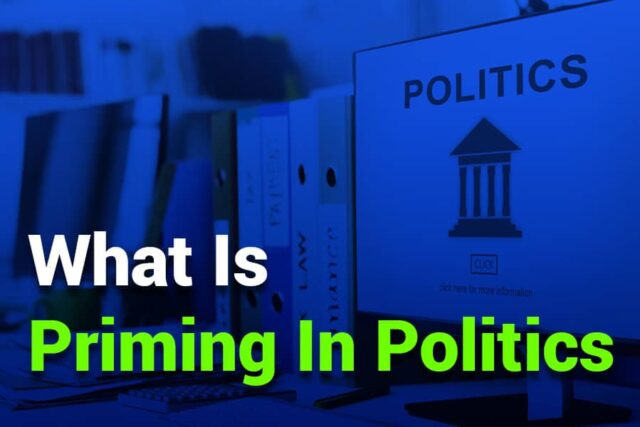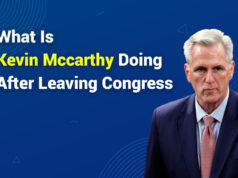Have you ever wondered why certain political issues seem to dominate conversations or how media coverage can shape your perception of a candidate? This phenomenon isn’t just coincidence—it’s a powerful psychological mechanism called priming. What is priming in politics, you ask? Priming is a strategy where emphasis on specific topics influences how people evaluate political leaders, policies, and events.
Whether it’s a campaign highlighting a candidate’s crisis management skills or media outlets focusing on economic issues during an election, priming works by steering public attention toward specific criteria for judgment. It subtly molds opinions and voting behavior, often without the audience even realizing it.
In this article, we’ll break down the concept of priming in politics, explore its real-world applications, and uncover the strategies that shape public opinion. Together, we’ll analyze how priming affects elections, influences media narratives, and plays a central role in modern democracy. So, let’s dive deeper into the mechanics of priming and understand the immense impact it has on political landscapes.
What is priming in politics?
Priming in politics is a communication strategy where specific issues or attributes are highlighted to influence public opinion and evaluation of political leaders or policies. By emphasizing particular topics, such as healthcare, national security, or economic performance, media and political campaigns guide voters to prioritize these issues when forming judgments. For instance, extensive media coverage of unemployment might lead voters to assess candidates based on their economic policies. This subtle yet powerful mechanism shapes perceptions and plays a crucial role in shaping political behavior and election outcomes.
Understanding the Power of Priming in Politics
Priming in politics is a nuanced yet influential technique that significantly impacts public perception and voter behavior. At its essence, priming involves directing attention to specific issues or attributes, subtly shaping how individuals evaluate political leaders, policies, or events. For instance, during times of heightened media focus on national security, voters are more likely to assess candidates based on their perceived ability to handle such concerns effectively.
This psychological mechanism works by activating mental frameworks that guide decision-making. Rather than persuading individuals to adopt new beliefs, priming enhances the salience of existing ones, encouraging people to apply these perspectives to the issues at hand. It operates as a lens through which political decisions and candidates are evaluated, profoundly influencing public discourse. Campaigns, debates, and media narratives often employ priming to emphasize certain priorities, ensuring these issues dominate the political agenda.
A crucial distinction of priming lies in its ability to frame the criteria by which political entities are judged. For example, a campaign might highlight a leader’s handling of economic challenges, subtly steering voters to prioritize fiscal competence in their evaluations. Conversely, media coverage during a national crisis might focus on leadership qualities, prompting voters to assess candidates based on their decisiveness and resilience.
Understanding what is priming in politics allows us to identify its pervasive influence on democratic processes. By elevating particular issues, priming determines how societies allocate attention and resources, shaping election outcomes and policy debates alike. This powerful tool, when wielded strategically, not only directs voter priorities but also reflects the broader dynamics of political communication.
From subtle shifts in public opinion to dramatic changes in electoral strategies, priming plays a pivotal role in the political landscape. Recognizing its influence is essential for fostering informed and critical engagement in democratic societies, empowering individuals to navigate the complexities of modern politics with clarity and insight.
How Does Priming Work in Political Communication?
Framing and Media Coverage
Media outlets play a crucial role in priming by selectively focusing on specific topics, shaping public attention, and influencing how people evaluate political issues. Through strategic coverage, media can emphasize certain aspects of a story, directing audiences to view political events or leaders through a particular lens. This selective framing not only highlights key issues but also determines the evaluation criteria the public uses to judge political leaders and their policies. Whether focusing on economic struggles or national security, media coverage serves as a powerful tool for shaping voter perceptions.
Campaign Strategies
Politicians often rely on priming as a central strategy to guide public opinion. By emphasizing their strengths—such as strong leadership during a crisis or success in economic reform—they can position themselves favorably in the eyes of voters. At the same time, they use priming to deflect attention from weaknesses or controversial aspects of their record. This selective focus allows candidates to control the narrative, ensuring that voters evaluate them based on criteria that align with their desired image. Campaign speeches, advertisements, and debates are all key platforms where priming strategies come into play.
Cognitive Activation
Priming works by activating mental shortcuts that influence how individuals process information and form judgments. When certain issues or attributes are repeatedly emphasized, they become more salient in voters’ minds, shaping their decision-making process. For instance, if a political campaign focuses heavily on healthcare, voters are more likely to use healthcare-related criteria when evaluating candidates, even if other issues are equally important. This cognitive activation ensures that the primed topics remain top-of-mind, influencing perceptions and choices.
Reinforcement of Biases
Priming also reinforces pre-existing attitudes by encouraging voters to interpret information through their preferred ideological lens. When media or campaigns emphasize issues that resonate with a particular political group, it strengthens existing beliefs and deepens partisan divides. This reinforcement makes voters more likely to evaluate candidates or policies in a way that aligns with their biases, further entrenching ideological viewpoints.
Examples in Action
Priming is often evident in political debates and responses to national crises. For instance, during healthcare debates, campaigns may emphasize the importance of affordable access, framing the conversation around policies that align with their goals. Similarly, in times of national disasters, narratives often shift toward leadership qualities, showcasing candidates who are perceived as strong and decisive. These examples illustrate how priming operates to align public narratives with specific political objectives, shaping voter priorities and influencing electoral outcomes.
Key Effects of Priming in Politics
Issue Salience: Priming significantly impacts what voters consider to be the most important issues. By emphasizing specific topics, such as healthcare, national security, or the economy, campaigns, and media elevate these matters to the forefront of public discourse. This process guides voters to prioritize these issues over others when evaluating political candidates and policies. For example, extensive coverage of economic instability may lead voters to focus more on fiscal policies than on other pressing matters like education or environmental reform.
Perception of Leaders: Focused narratives created through priming shape public perceptions of a leader’s competence and character. Highlighting specific achievements or failures allows politicians to craft an image that aligns with the values and concerns of their target audience. For instance, a leader’s handling of a crisis might be framed as evidence of their strong leadership skills, while missteps in other areas may be downplayed or ignored. This selective emphasis plays a critical role in how voters perceive and judge political figures.
Agenda Setting: Politicians and media outlets use priming as a tool to set the agenda for public discourse. By defining the topics that dominate political conversations, they influence what the public deems most important. This power to shape the narrative ensures that certain issues receive more attention, often reflecting the strategic goals of campaigns or the biases of media organizations. This agenda-setting effect reinforces the priming process, keeping selected issues at the forefront of voter consciousness.
Voter Decision-Making: Priming affects the criteria voters use when deciding which candidates to support. By focusing attention on specific issues or attributes, priming guides voters to evaluate candidates based on those particular metrics. For example, during a period of heightened national security concerns, voters may prioritize a candidate’s defense policies over their stance on healthcare. This targeted influence shapes the outcome of elections by aligning voter priorities with strategically highlighted issues.
Polarization: Strategic priming can deepen political divides by reinforcing partisan viewpoints. Selectively emphasizing issues that resonate strongly with specific ideological groups, campaigns, and media contributes to increased polarization. This creates an “echo chamber” effect, where voters are exposed primarily to narratives that align with their existing beliefs, making it harder to find common ground across political divides.
Examples of Priming in Political Contexts
Priming is a critical concept in understanding the dynamics of political communication. But what is priming in politics, and how does it manifest in campaigns and media coverage? At its core, priming involves emphasizing specific issues to shape how voters evaluate political leaders, policies, or events. This strategic focus is particularly evident during periods of economic or national crises.
For example, during economic downturns, political campaigns often highlight unemployment rates and financial instability to draw voter attention to fiscal policies. By doing so, they encourage voters to assess candidates based on their economic plans and management skills. Similarly, in the wake of national crises, such as terrorist attacks, the narrative often shifts to emphasize security and leadership. This redirection of focus influences voters to prioritize these issues when evaluating political candidates, often favoring those perceived as strong and capable leaders.
Debates are another arena where priming plays a significant role. Political candidates use debates to strategically emphasize their strengths, whether it’s economic expertise, healthcare reform, or social justice advocacy. By framing the conversation around these topics, they aim to align audience evaluations with their desired image. For instance, a candidate well-versed in economic matters may steer the discussion toward fiscal policies, while another advocating for civil rights may highlight social equity issues.
Media coverage amplifies the effects of priming by selectively focusing on certain narratives and omitting others. News outlets play a pivotal role in shaping public opinion by choosing which stories to highlight and how to frame them. This selective emphasis not only guides voter attention but also reinforces the priming effects initiated by political campaigns.
These examples demonstrate how priming operates as a powerful tool for shaping political landscapes and influencing electoral outcomes. Understanding what is priming in politics allows voters to critically evaluate the narratives presented to them, fostering a more informed and balanced perspective on the issues that matter most.
Why Understanding Priming Is Important in Politics?
Impact on Elections
Priming has a significant influence on election outcomes by shaping voter priorities and evaluations of candidates. By emphasizing specific issues, political campaigns, and media narratives guide voters to focus on certain aspects of leadership or policy, ultimately affecting their decision-making. For instance, when economic issues are heavily highlighted, voters are more likely to evaluate candidates based on their economic policies and competence. This targeted influence can shift the trajectory of an election, demonstrating the powerful role priming plays in determining political success.
Media Accountability
Media organizations play a central role in the process of priming, as they control much of the information that reaches the public. By understanding the mechanics of priming, it becomes possible to hold these organizations accountable for balanced reporting and agenda setting. When media outlets disproportionately focus on particular issues, they inadvertently shape public perception and influence electoral outcomes. Greater awareness of priming encourages the demand for diverse and balanced coverage, ensuring that no single narrative dominates the political landscape.
Voter Awareness
An informed electorate is the foundation of a healthy democracy, and recognizing the role of priming is an essential part of voter education. When voters understand how priming works, they can critically evaluate political messaging and make decisions based on a broader perspective. This awareness reduces the likelihood of being swayed by strategically emphasized issues and fosters independent, informed decision-making. Educated voters can also demand greater transparency from political campaigns and media outlets, promoting a more equitable political process.
Democratic Health
Priming’s influence extends beyond individual elections, shaping the overall health of democratic systems. By highlighting the mechanics of priming and its impact on voter behavior, societies can foster greater transparency and accountability. Understanding these dynamics allows for the creation of fairer political practices, encouraging leaders to focus on substantive issues rather than manipulating public perception. Ultimately, addressing the implications of priming contributes to a more robust and inclusive democracy, where voters have the tools to engage critically and thoughtfully with the political process.
Conclusion
Priming in politics is a powerful mechanism that shapes public opinion, influences electoral outcomes, and defines the political agenda. By emphasizing specific issues, political campaigns, and media outlets guide voters toward particular judgments, often without their conscious awareness. Understanding what is priming in politics is crucial for recognizing these tactics and fostering informed, independent decision-making in democratic systems. As voters, being aware of priming’s influence allows us to engage critically with political messaging and prioritize issues based on personal values rather than strategic narratives.
FAQ’s
Q. What is priming in politics, and how does it differ from framing?
A. Priming focuses on influencing how people evaluate issues by emphasizing specific topics, while framing shapes how information is presented and interpreted.
Q. How does priming affect voter behavior?
A. Priming guides voters to prioritize certain issues, influencing the criteria they use to evaluate political candidates and policies.
Q. Can priming be considered manipulation?
A. While not inherently manipulative, priming can be used strategically to steer opinions, making it important for voters to remain critical and informed.
Q. What role does media play in priming?
A. Media serves as a primary agent of priming by highlighting specific issues, shaping public discourse, and influencing voter priorities.
Q. How can voters recognize and counteract priming?
A. Voters can counteract priming by seeking diverse information sources, staying informed about a range of issues, and critically evaluating political messaging.














